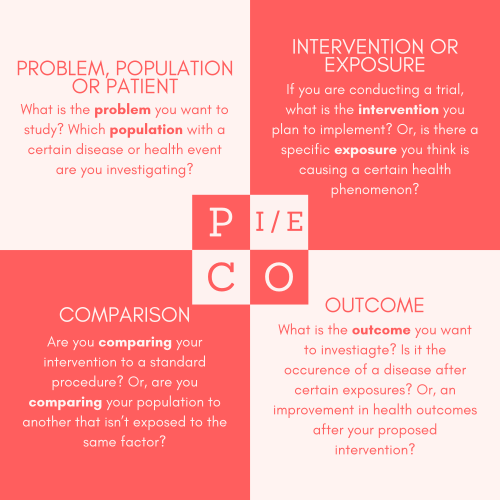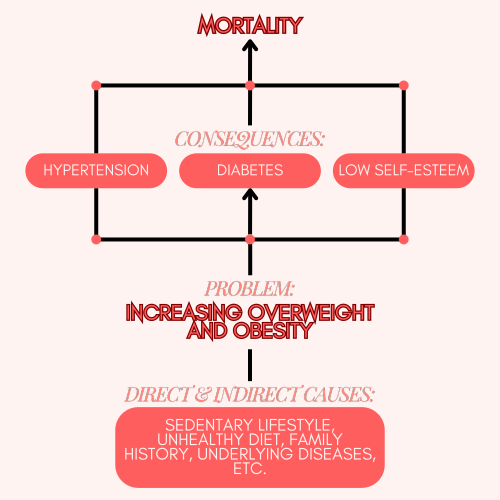
The initial step you must take is to identify a specific challenge or gap in your field of work (The Research Problem). After you identify the problem, you need to analyse the problem (e.g. the causes, and the consequences of it) to justify the importance of conducting the research. This helps refine the framing of your research question. Examples of research questions you may ask are: ‘Could a specific new hygiene practice reduce maternal deaths in rural health care settings in East Africa?’ or ‘Could sending informative text messages to nurses help them explain to HIV patients how to take their treatments?’.
Having a clear research question helps you in various ways when developing your study - including narrowing down your data collection and analysis efforts to the essential points, and helps the reader understand what the objectives of your study are. A very helpful framework to guide you in formulating your research question is the PICO or PECO Framework.

Figure 1: the PICO/PECO Framework.
Steps in Setting Research Question
First Step: Identify Your Research Problem
The problem identification is the starting point. It is the recognition of a challenge, need or gap in knowledge.
Then, you may identifythe causes of the problem and associated factors. This can be based on local knowledge, literature review, local or national priorities, or discussion with your research team.
It is important to identifythe frequency, intensity, and geographical distribution of the problem to show the importance of addressing the problem.
With this, we can construct the problem tree:
-
What is the central problem is?
-
What is causing the problem?
-
What are the consequences or effects of that problem? This will justify why it is important to address the problem.
EXAMPLE:
|
Central problem |
Increasing overweight and obesity. |
|
Causes |
Multifactorial problem. Direct and indirect causes: sedentary lifestyle, diet, family history, underlying diseases. |
|
Consequences |
Hypertension, diabetes, decreased self-esteem, mortality. With information about them, you can justify why it is important to investigate, to propose a treatment to reduce the consequences. |

Figure 2: A problem tree example.
Second Step: Conduct Your Literature Review
What has already been done or what evidence is available regarding your proposed study?
A good and up-to-date literature review is essential to:
-
Provide context, justification, and support for your research question
-
Understand the extent of the problem
-
Identify the causes and factors that influence the problem
-
Identify the gap in the current literature landscape
Reading literature in your field allows you to stay on top of your game. If you’re in a field you’re interested in, this should not be too arduous.
The reading must go from the start to the end of the research process. If not, by the time you publish, there may already be a similar article published!
There are different types of literature, outlined below in Table 2:
Types of Literature
|
Published |
We find it in manual searches-by contacting researchers involved in the field of interest- or databases searches -high impact journals, Pubmed, Google academic/ Google scholar, ScienceDirect, Scopus, Scielo and LILACs (in Latin America), etc. Access depends on the licenses held by the journals that publish them. |
The literature that reviewers have the most confidence in. |
|
Grey |
Information that is produced outside of traditional publishing and distribution channels. It is produced on all levels of government, academia, business, and industry in electronic and print formats and it is not controlled by commercial publishing. It involves different national or international organisations such as the WHO, health ministries, and the World Bank. |
In general, they do not have much credibility because they do not go through peer and independent reviewers or reviewers from other institutions. They are very useful to get an idea of the local context, and to frame a problem well. |
|
Unpublished |
Expert Interviews, academic Meetings participation, congress participation, personal conversations. |
|
Third Step: Set out your research aim, objectives, hypothesis and/or research question
Definition of Terms:
|
TERM |
DEFINITION |
|
Research aim |
A statement indicating the general aim or purpose of a research project. Usually, a research project will have only one broad aim.
|
|
Research objectives |
Specific statements indicating the key issues to be focused on in a research project. Usually, a research project will have several specific objectives. |
|
Research questions |
An alternative to research objectives, where the key issues to be focused on in a research project is stated in the form of questions. |
|
Research hypotheses |
A prediction of a relationship between two or more variables, usually predicting the effect of an independent variable on a dependent variable. The independent variable is the variable assumed to have a casual influence on the outcome of interest, which is the dependent variable. |
Study aim or overall objective:
-
The overall objective of a study states what the researchers hope to achieve with the study in general terms.
-
They should be closely related to the problem statement. When evaluating the project, objectives are contrasted with results. If the objectives are not clearly stated, the evaluation cannot be done.
Why should we formulate research objectives?
It will help you to:
-
Focus on the study (by narrowing it down to its essential points).
-
Avoid collecting data that is not strictly necessary to understand and solve the problem you have identified.
-
Organise the study into clearly defined parts or phases.
|
How should you set out your objectives?
|
Specific objectives:
-
Specific objectives are quantifiable results at a specific time for the project. They are concrete measures to respond to the big question.
-
List your specific objectives as a chronological sequence or logical flow: objective 1/ objective 2/ objective 3. Avoid listing activities that will be included in the methods part.
-
Research objectives can be descriptive, methodological (e.g., evaluating a lab technique), differential, or relational (e.g., comparing factors that influence x).
Keep in mind that not all research projects have hypotheses.
Example of a study's overall objective and specific objectives:
|
Objective: To assess the factors determining low adherence to the therapeutic regimen in patients who have received counselling and close monitoring in City X between July 2018 and July 2019. Specific objectives: To determine:
|
-
A good study comes down to setting a single and clear question, which is your primary objective, and then determining what you are going to measure in order to answer that question:- your primary endpoint. If you keep this in mind in everything you do, then you will run a good study. What is my question? Is what I am doing going to answer that question – accurately?
Refer to the PICO or PECO Framework illustrated in Figure 1 above to formulate your question.
Do you need more help? Please find the links to more resources
-
WWARN has a collection of literature reviews that provide valuable resources for researchers as they develop their clinical study programmes. These reviews are a valuable reference tool for researchers to identify gaps in data and information, consider publication trends over time, consider the different study approaches and identify relevant clinical studies which might contribute trial patient results for further pooled analyses (see WWARN study groups).
-
WWARN Tools: monitor and track the emergence and spread of antimalarial resistance find out more here.
-
The process map: https://processmap.tghn.org/?mapnode=develop-research-question
-
For additional support, you can access our free training e-learning course: The Research Question: https://globalhealthtrainingcentre.tghn.org/elearning/education/elearning-courses/the-research-question/37/